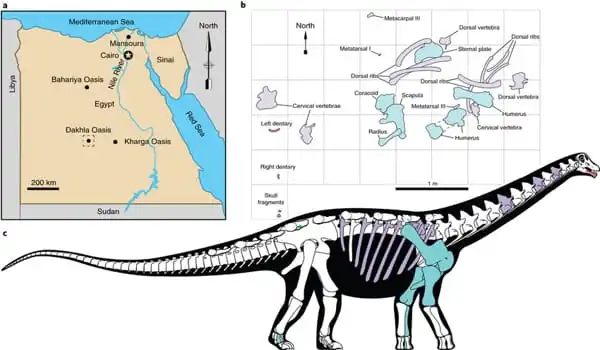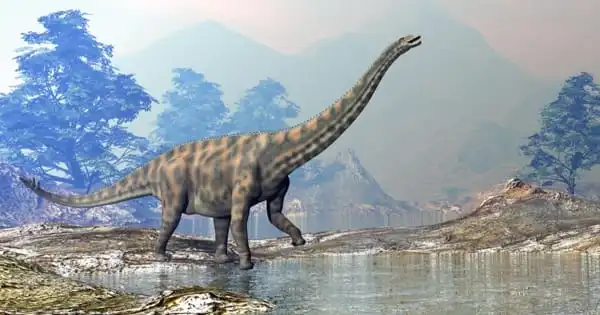The skeleton of Abditosaurus kuehnei is the most complete titanosaur fossil found in Europe to date. Abditosaurus kuehnei, a new species of titanosaur dinosaur discovered at the Orcau-1 site in the southern Pyrenees, has been described by researchers (Catalonia, Spain).
The new species of titanosaur dinosaur Abditosaurus kuehnei was described by researchers from the Institut Català de Paleontologia Miquel Crusafont (ICP), the Conca Dellà Museum (MCD), the Universitat Autnoma de Barcelona (UAB), the University of Zaragoza (UNIZAR), and the NOVA University of Lisbon (UNL) from the remains excavated at the Orcau-1 site in the southern Py (Catalonia, Spain). The semiarticulated 70.5-million-year-old skeleton is Europe’s most complete specimen of this herbivorous dinosaur group.
Furthermore, Abditosaurus is the largest titanosaur species found in the Ibero-Armorican island – an ancient region that now includes Iberia and the south of France – with a senescent individual estimated to be 17,5 meters long and weighing 14,000 kg.
One of the most surprising facts to researchers is the size of this giant. “Titanosaurs from Europe’s Upper Cretaceous tend to be small or medium-sized due to their evolution in insular conditions,” explained Bernat Vila, paleontologist at the ICP who led the study. Europe was a large archipelago made up of dozens of islands during the Upper Cretaceous period (between 83 and 66 million years ago). Because of the limited food resources on islands, the species that evolved there tend to be small, or even dwarves, compared to their relatives living on larger landmasses. “It is a recurring phenomenon in the history of life on Earth, and we have several examples of this evolutionary trend in the fossil record all over the world. That’s why we were astonished by the large dimensions of this specimen,” said Vila.
During the Jurassic and Cretaceous periods, Iberia served as a link between Eurasia, Africa, and North America. The study of Abditosaurus’ relationship to the fauna of these continents helps us understand when they were connected and when they became isolated.
Miguel Moreno
Over several decades of fieldwork, 53 skeletal elements of the specimen were discovered. There are several teeth, vertebrae, ribs, limb, scapular, and pelvic bones, as well as a semiarticulated neck fragment made up of 12 cervical vertebrae. “We were extremely fortunate; it is unusual to find such complete specimens in the Pyrenees due to its troubled geologic history,” says ICP researcher and Conca Dellà Museum director ngel Galobart (Isona, Catalonia).
The excavation of the neck in 2014 was technically difficult. The neck was encased in a large block of polyurethane foam once it was ready for extraction, becoming one of the largest jackets ever excavated in Europe.
The research that resulted in the new species’ description began in 1954, when German paleontologist Walter Kühne collected the first remains and sent them to Madrid. The site was forgotten until 1986, when some more remains were extracted before the excavation was halted due to a massive storm. Following that, fieldwork at the site faded into obscurity until an ICP paleontologist resumed systematic excavations at Orcau-1. The story of this discovery was told in the documentary “Europe’s Last Giant,” which was released in 2017. The generic name Abditosaurus means “forgotten reptile,” and the specific name kuehnei honors its discoverer.

A migrating dinosaur
Researchers conclude in their article published in Nature Ecology & Evolution that Abditosaurus belongs to a group of saltasaurine titanosaurs from South America and Africa, distinct from the rest of the European titanosaurs, which are smaller in size. The authors propose that the Abditosaurus lineage arrived on the Ibero-Armorican island as a result of a global drop in sea level, which reactivated ancient migration routes between Africa and Europe.
“Other evidence supports the migration hypothesis,” says Albert Sellés, an ICP paleontologist and co-author of the study. “At the same site, we discovered eggshells of dinosaur species known to have lived on Gondwana, the world’s southernmost continent.”
The new discovery represents a significant advance in our understanding of the evolution of sauropod dinosaurs at the end of the Cretaceous period, bringing a new perspective to the phylogenetic and paleobiogeographic puzzle of sauropods in the last 15 million years before extinction.
In addition to Vila, Sellés, and Galobart, this study included Novella Razzolini (Institut Català de Paleontologia Miquel Crusafont and Conca Dellà Museum), Miguel Moreno (Museu de Lurinh and NOVA University of Lisbon), Iaki Canudo (Aragosaurus-IUCA Group, University of Zaragoza), and Alejandro Gil (Universitat Autnoma de Barcelona).
“During the Jurassic and Cretaceous periods, Iberia served as a link between Eurasia, Africa, and North America. The study of Abditosaurus’ relationship to the fauna of these continents helps us understand when they were connected and when they became isolated” According to Miguel Moreno, a researcher at the Museu de Lurinh and NOVA University of Lisbon who conducted the paleobiogeographic study.
The large Cretaceous herbivores
Titanosaurs are a type of sauropod dinosaur that became very diverse and abundant in Cretaceous terrestrial ecosystems. They were all quadrupeds and phytophagous. Titanosaurs had a small, pointed skull with small, nail-shaped teeth that they used to uproot vegetation. Their bodies were strong, with forelimbs that were shorter than hindlimbs and long necks and tails. Some species had skin covered with bony plates called osteoderms, which may have served as a protective shield or a calcium reserve.
Over the last century, the Catalan Pyrenees paleontological sites have yielded exceptional dinosaur fossils. The research is especially significant because it contains the last vertebrate faunas, including non-avian dinosaurs, that lived in Europe just before the global extinction event that occurred 66 million years ago.





